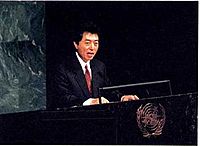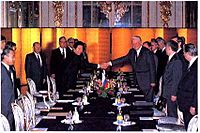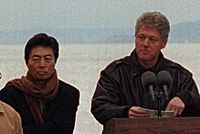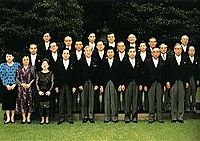Morihiro Hosokawa facts for kids
Quick facts for kids
Morihiro Hosokawa
|
|
|---|---|
|
細川 護熙
|
|

Official portrait, 1993
|
|
| Prime Minister of Japan | |
| In office 9 August 1993 – 28 April 1994 |
|
| Monarch | Akihito |
| Preceded by | Kiichi Miyazawa |
| Succeeded by | Tsutomu Hata |
| Leader of the New Party | |
| In office 22 May 1992 – 9 December 1994 |
|
| Preceded by | Party established |
| Succeeded by | Party abolished |
| Governor of Kumamoto Prefecture | |
| In office 11 February 1983 – 10 February 1991 |
|
| Monarch | Hirohito Akihito |
| Preceded by | Issei Sawada |
| Succeeded by | Joji Fukushima |
| Member of the House of Representatives | |
| In office 18 July 1993 – 7 May 1998 |
|
| Preceded by | Shōichi Tanaka |
| Succeeded by | Eiichi Iwashita |
| Constituency | Former Kumamoto 1st (1993–1996) Kumamoto 1st (1996–1998) |
| Member of the House of Councillors | |
| In office 26 July 1992 – 4 July 1993 |
|
| Preceded by | Multi-member district |
| Succeeded by | Keizō Kojima |
| Constituency | National PR |
| In office 4 July 1971 – 11 February 1983 |
|
| Preceded by | Multi-member district |
| Succeeded by | Masaru Urata |
| Constituency | National district (1971–1977) Kumamoto at-large (1977–1983) |
| Personal details | |
| Born | 14 January 1938 Tokyo, Empire of Japan |
| Political party | Democratic (1998–2016) |
| Other political affiliations |
LDP (until 1992) JNP (1992–1994) NFP (1994–1997) From Five (1997–1998) GGP (1998) |
| Spouse |
Kayoko Ueda
(m. 1971) |
| Children | 3 (including Morimitsu) |
| Relatives | Tadateru Konoe (brother) |
| Alma mater | Sophia University |
| Signature | |
Morihiro Hosokawa (細川 護煕, Hosokawa Morihiro, born 14 January 1938) is a Japanese politician. He served as the Prime Minister of Japan from 1993 to 1994. He led a special group of eight political parties. This was the first time since 1955 that Japan's government was not led by the Liberal Democratic Party (LDP).
Morihiro Hosokawa was born into an important family in Kumamoto Prefecture. His grandfather was Prince Fumimaro Konoe, who was also a prime minister. Hosokawa studied at Sophia University. After that, he worked as a journalist for the Asahi Shimbun newspaper. In 1971, he was elected to Japan's parliament, called the National Diet. Later, he became the governor of his home area, Kumamoto, from 1983 to 1991.
In 1992, Hosokawa left the LDP. He started a new party called the Japan New Party. This party wanted to make changes in politics. In the 1993 general election, his new party won 35 seats. The LDP lost its main power, and an eight-party group, led by Hosokawa, took over. He started important changes to how elections worked. In 1994, he stepped down, and Tsutomu Hata took over the leadership of the group. Hosokawa later joined other parties before leaving politics. Since 2005, he has been the head of the Hosokawa clan, a very old family in Japan.
Contents
Early Life and Education
Morihiro Hosokawa was born in Tokyo. He was the oldest grandson of Moritatsu, 3rd Marquess Hosokawa. His family was the head of the Hosokawa clan. His mother's father was Prince Fumimaro Konoe, who was prime minister of Japan several times. Hosokawa is also related to the current emperor, Naruhito. He is a descendant of a famous Christian woman named Gracia Hosokawa.
Hosokawa earned his law degree from Sophia University in 1961.
Political Journey
After college, Hosokawa worked as a journalist for the Asahi Shimbun newspaper for five years. In 1969, he tried to get elected to parliament but didn't win that time. In 1971, he was elected to the House of Councillors of Japan. This is one of the two houses of Japan's parliament. He represented Kumamoto Prefecture and was part of the LDP.
After serving two terms in the National Diet, Hosokawa left in 1983. He became the governor of Kumamoto, his home prefecture. He served as governor until 1991. During his time as governor, he often spoke about how the central government's powerful rules affected local areas. Hosokawa worked to improve the economy and made stronger laws to protect the environment. In May 1992, he decided to form a new party. It was called the Japan New Party (JNP). This party wanted to bring about political changes. The JNP won four seats in the 1992 election. Hosokawa took one of these seats.
Becoming Prime Minister (1993–1994)

In the July 1993 general election, something big happened. The LDP, which had been in power for 38 years, lost its majority in the parliament. They won only 223 out of 511 seats. The government led by Kiichi Miyazawa of the LDP was replaced. A new group of eight parties formed a government. This new group promised to make many social, political, and economic changes.
This group included Hosokawa's new party, the Japan New Party. It also included the Japan Socialist Party, the Japan Renewal Party, Komeito, and others. Together, they had 243 seats. Hosokawa was a key person in bringing these parties together. He was chosen to be the new Prime Minister.
Walter Mondale, who was the US ambassador to Japan at the time, said Hosokawa was good at focusing on big ideas. However, the parties in Hosokawa's group did not always agree on everything. Their main shared goal was to oppose the LDP. This made it difficult for Hosokawa during his time as prime minister. He also wanted to change how Japan's government offices worked.
Foreign Relations


As prime minister, Hosokawa made important steps to apologize to Japan's Asian neighbors. These apologies were for actions taken during World War II. In his first press conference, he clearly stated that Japan had waged a war of aggression.
He later explained that Japan had caused great suffering and loss of life in China, Korea, and Southeast Asian countries. He believed it was important to admit this. On November 6, 1993, he visited South Korea. There, he met with President Kim Young-sam and again apologized to the Korean people. This was praised in Korea. Hosokawa believed that Japan's takeover of Korea was wrong.
On March 19, 1994, he visited China. The two countries signed an agreement to work together on protecting the environment. Hosokawa's actions towards China and Korea even inspired Russian president Boris Yeltsin to apologize to Hosokawa. This apology was for the Soviet Union holding Japanese prisoners of war in Siberia. Hosokawa thought that if they had both stayed in office longer, relations between Russia and Japan would have gotten much better. Hosokawa also had a good relationship with US President Bill Clinton. However, trade disagreements between Japan and the United States were a big topic during his time.
Changes at Home
The Hosokawa government worked to change Japan's election laws. These changes aimed to stop political corruption. They wanted to stop companies from giving money directly to individual politicians. They also wanted to redraw the election map. These changes were meant to prevent the LDP from using old election practices. After much debate, the LDP managed to keep some of their advantages. They kept corporate donations but with a limit. They also made sure that most politicians would keep their same election areas. These compromises made the public less happy with Hosokawa's government.
In December 1993, a new law was passed. It aimed to help people with disabilities live more independently. It also encouraged them to take part in activities like culture, economy, and community life. On March 30, 1994, rules about industrial safety were updated. Accidents involving cranes or broken wires had to be reported to the authorities. On April 1, 1994, a 40-hour workweek was introduced in Japan.
Hosokawa also cut income and resident taxes. This was meant to help Japan recover from a difficult economic time. After discussions with the finance ministry, the government announced a plan to increase the sales tax from 3% to 7% in 1997. This idea caused disagreements within the government. Hosokawa announced the increase but then took it back the next day. The tax stayed at 3%. This issue weakened his government's power. The sales tax was later increased to 5% in 1997 by a different prime minister.
Resignation
Hosokawa had to resign in April 1994. This happened after it was revealed that he had received a large loan from a company. This company had been accused of being involved in bribery. Hosokawa said the money was a loan and showed a receipt that he had paid it back. Even though many people still liked Hosokawa, some felt he could not meet the high hopes set for him.
Hosokawa's resignation was sudden. It led to many meetings to try and save the group of parties he led. After he resigned, Tsutomu Hata took over the leadership of the group.
Hosokawa's Cabinet
The group of ministers who worked with Morihiro Hosokawa was called the Hosokawa Cabinet. It was made up of people from his multi-party group. However, many of the main ministers were from the Shinseito party. Hosokawa's own Japan New Party did not have other members in the cabinet.
| Chief Cabinet Secretary | Masayoshi Takemura (Sakigake) |
|---|---|
| Foreign Affairs | Tsutomu Hata (Shinseito) |
| Justice | Akira Mikazuki (non-affiliated) |
| Finance | Hirohisa Fujii (Shinseito) |
| Education | Yoko Akamatsu (non-affiliated) |
| Health and Welfare | Keigo Ouchi (Democratic Socialist) |
| Labor | Chikara Sakaguchi (Komeito) |
| Agriculture, Forestry and Fisheries | Eijiro Hata (Shinseito) |
| International Trade and Industry | Hiroshi Kumagai (Shinseito) |
| Transport | Shigeru Ito (Socialist) |
| Construction | Kozo Igarashi (Socialist) |
| Home Affairs and National Public Safety Commission | Kanju Sato (Socialist) |
| Posts and Telecommunications | Takenori Kanzaki (Komeito) |
| Management and Coordination Agency | Koshiro Ishida (Komeito) |
| Japan Defense Agency | Hiroyoshi Nakanishi (Shinseito) until 1 December 1993 Kazuo Aichi (Shinseito) after 2 December 1993 |
| Hokkaido and Okinawa Development, National Land Agency | Kosuke Uehara (Socialist) |
| Economic Planning Agency | Manae Kubota (Socialist) |
| Environment | Wakako Hironaka (Komeito) |
| Council for Science and Technology Policy | Satsuki Eda (Democratic Socialist) |
| Minister of State | Sadao Yamahana (Socialist) |
Life After Politics
Hosokawa joined the New Frontier Party in 1994. But he left in 1997 with four other politicians. They formed a small party called From Five. In 1998, From Five joined another party, which then joined the Democratic Party of Japan (DPJ).
After the LDP came back to power in 1994, Hosokawa worked with Junichiro Koizumi from the LDP. They talked about Japan possibly becoming a permanent member of the United Nations Security Council. This idea was not very popular in the LDP. However, Hosokawa and Koizumi stayed close friends. Hosokawa sometimes helped Koizumi with relations between Japan and China.
Hosokawa retired from politics in 1998 when he was 60 years old. In his retirement, he started making pottery. He studied for 18 months with a pottery master. Hosokawa's pottery has been shown in Japan and Europe. He uses his pottery for tea ceremonies. He is also a special advisor to The Japan Times newspaper. When his father passed away in 2005, Hosokawa became the head of the Hosokawa family.
Running for Tokyo Governor
In 2014, when he was 75, Hosokawa was asked to run for governor of Tokyo. He first said no. But then former Prime Minister Junichiro Koizumi encouraged him to run. Koizumi wanted to gather public support against Prime Minister Shinzō Abe's policies on nuclear power. Hosokawa then decided to run. Many people saw this election as a competition between Abe and Koizumi.
Hosokawa announced he was running on January 14, with Koizumi by his side. Several important people from his 1993-94 government supported his campaign. This included Banri Kaieda and Ichirō Ozawa.
During his campaign, Hosokawa spoke against the government's nuclear power plans. He said that Tokyo uses a lot of electricity but sends nuclear power plants and waste to other regions. He also questioned if aggressive foreign policy would help the 2020 Summer Olympics in Tokyo be peaceful.
Hosokawa did not gain enough support. He was behind the other main candidate, Yōichi Masuzoe, in the polls. Masuzoe won the election on February 9. However, Hosokawa promised to keep speaking out against nuclear power.
Personal Life
Hosokawa lives in Yugawara, Kanagawa. He married Kayoko Ueda on October 23, 1971. His wife, Kayoko Hosokawa, has been involved in many good causes. She was the honorary chair of the Special Olympics Nippon Foundation. She also led groups that provide vaccines to children in developing countries and help people with intellectual disabilities. Morihiro and Kayoko have three children: Morimitsu, Satoko, and Yūko.
See also
 In Spanish: Morihiro Hosokawa para niños
In Spanish: Morihiro Hosokawa para niños



